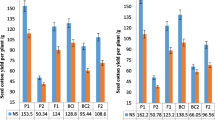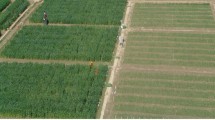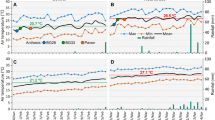Abstract
Heat stress is a major productivity lowering factor in wheat. Wild progenitor species offer a wide spectrum of adaptation traits and can serve as valuable donors of stress tolerance. In the present study, genetic variation in 129 accessions of Aegilops tauschii Coss., the D genome donor of wheat, was evaluated for two heat tolerance related traits viz., cell membrane stability (CMS) and TTC (2,3,5-Triphenyl tetrazolium chloride) based cell viability. Cell membrane stability in the Ae. tauschii accessions at vegetative stage ranged from 15.24 to 80.39%. Nineteen Ae. tauschii accessions were superior to the tolerant bread wheat control (C 273). At anthesis stage a similar spectrum of variation was observed with twenty three accessions showing higher cell membrane stability than C 273. The average CMS level of entire germplasm set at anthesis (47.61%) was lower than at vegetative stage (58.89%). Clear genotypic differences were also observed for TTC based cell viability test. Ae. tauschii accessions displayed a range from 18.73 to 84.39% with eight genotypes excelling over tolerant bread wheat. Correlation of CMS values recorded at two stages was significant but of low predictive value (r2 = 0.137). Similarly significant but moderate correlation was obtained between CMS and TTC test (r2 = 0.325). Consequently all the three parameters were used to derive a cell thermotolerance index which was in turn used to identify ten tolerant Ae. tauschii genotypes. The identified accessions were re- evaluated for 1 more year and the three parameters viz., CMS at vegetative (r2 = 0.954) and anthesis stage (r2 = 0.932) and TTC cell viability at vegetative stage (r2 = 0.888) showed high correlation Strategy for use of identified accessions as donors is discussed.




Similar content being viewed by others
References
Azhar MT, Khan AA, Khan IA (2005) Combining ability analysis of heat tolerance in Gossypium hirsutum L. Czech. J Genet Plant Breed 41:23–28
Bala S (2008) Studies on carbon and nitrogen metabolism in relation to sink strength under high temperature stress in wheat. M.Sc. Thesis, Punjab Agricultural University, Ludhiana
Blum A (1998) Improving wheat grain filling under heat stress by stem reserve mobilization. Euphytica 100:77–83
Blum A, Ebercon A (1981) Cell membrane stability as measure of drought and heat tolerance in wheat. Crop Sci 21:43–47
Blum A, Mayer J, Gozlan G (1982) Infrared thermal sensing of plant canopies as a screening technique for dehydration avoidance in wheat. Field Crop Res 5:137–146
Caldwell KS, Dvorak J, Lagudah ES, Ahkunov E, Luo M, Molters P, Powell W (2004) Sequence polymorphism in polyploid wheat and their D genome diploid ancestor. Genetics 167:941–947
Chen HH, Shen ZY, Li PH (1982) Adaptability of crop plants to high temperature stress. Crop Sci 22:719–725
Cox TS (1998) Deepening the wheat gene pool. J Crop Prot 1:1–25
Dhanda SS, Munjal R (2006) Inheritance of cellular thermotolerance in bread wheat. Plant Breed 125:557–564
Fokar M, Nguyen HT, Blum A (1998) Heat tolerance in spring wheat, I. Genetic variability and heritability of cellular thermotolerance. Euphytica 104:1–8
Gill BS, Raupp WJ (1987) Direct genetic transfer from Aegilpos squarossa L. to hexaploid wheat. Crop Sci 27:445–450
Ibrahim AMH, Quick JS (2001) Heritability of heat tolerance in winter and spring wheat. Crop Sci 41:1401–1404
Ismail MA, Hall AE (1999) Reproductive-stage heat tolerance, leaf membrane stability and plant morphology in cowpea. Crop Sci 39:1762–1768
Joshi AK, Mishra B, Chatrath R, Ferrara GO, Ravi PS (2007) Wheat improvement in India, present status, emerging challenges and future prospects. Euphytica 157:431–446
Martineau JR, Williams JH, Specht JE (1979) Temperature tolerance in soybeans. II. Evaluation of segregating populations for membrane thermostability. Crop Sci 19:79–81
Porter DR, Nguyen HT, Burke JJ (1995) Genetic control of acquired high temperature tolerance in winter wheat. Euphytica 83:153–157
Rane J, Pannu RK, Sohu VS, Saini RS, Mishra B, Shoran J, Crossa J, Vagas M, Joshi AK (2007) Performance of yield and stability of advanced wheat genotypes under heat stress environments of the Indo-Gangetic plains. Crop Sci 47:1561–1573
Reynolds MP, Balota M, Delgado MIB, Amani I, Fischer RA (1994) Physiological and morphological traits associated with spring wheat yield under hot irrigated conditions. Aust J Plant Physiol 21:717–730
Reynolds MP, Saint Poerre C, Saad ASI, Vargas M, Condon AG (2007) Evaluating potential gains in wheat associated with stress adaptive trait expression in elite genetic resources under drought and heat stress. Crop Sci 47:172–189
Sadalla MM, Shanahan JF, Quick JS (1990a) Heat tolerance in winter wheat. I. Hardening and genetic effects on membrane thermostability. Crop Sci 30:1243–1247
Sadalla MM, Quick JS, Shanahan JF (1990b) Heat tolerance in winter wheat. II. Membrane thermostability and field performance. Crop Sci 30:1248–1251
Sehgal S (2005) Studies on incorporation of Karnal Bunt resistance and productivity traits from Aegilops tauschii Coss. into wheat (Triticum aestivum L.). PhD Thesis, Punjab Agricultural University, Ludhiana
Singh RP, Huerta-Espino J, Sharma R, Joshi AK, Trethowan R (2007) High yielding spring wheat germplasm for global irrigated and rainfed production systems. Euphytica 157:351–363
Skovmand B, Reynolds MP, Delacy IH (2001) Mining wheat germplasm collections for yield enhancing traits. Euphytica 119:26–32
Sullivan CY, Ross WM (1979) Selecting for drought and heat resistance in grain sorghum. In: Mussell H, Staples RC (eds) Stress physiology in crop plants. Wiley, New York, pp 263–281
Trethowan RM, Mujeeb-Kazi A (2008) Novel germplasm resources for improving environmental stress tolerance of hexaploid wheat. Crop Sci 48:1255–1265
Trethowan RM, Hodson D, Braun HJ, Pfeiffer WH (2005) Wheat breeding environments, 1988–2002. In: Dubin J, Lantican MA, Morris ML (eds) Impacts of international wheat breeding research in the developing world. CIMMYT, Mexico, DF, pp 4–11
Valkoun JJ (2001) Wheat prebreeding using wild progenitors. Euphytica 119:17–23
Van Slageren MW (1994) Wild wheats L, a monograph of Aegilops L. and Amblyuopyrun (Jaub. and Spach). Eig Wageningen Agricultural University and ICARDA
Yang J, Sears RG, Gill BS, Paulsen GM (2002) Growth and senescence characteristics associated with tolerance of wheat-alien amphiploids to high temperature under controlled conditions. Euphytica 126:185–193
Zadoks JC, Chang TT, Konzak CF (1974) A decimal code for the growth stages of cereals. Weed Res 14:415–421
Zaharieva M, Gaulin E, Havaux M, Acevedo E, Monneveux P (2001) Drought and heat responses in the wild wheat relative Aegilops geniculata Roth. potential interest for wheat improvement. Crop Sci 41:1321–1329
Zohary D, Harlan JR, Vardi A (1969) The wild diploid progenitors of wheat and their breeding value. Euphytica 18:58–65
Acknowledgments
We acknowledge the financial support provided for this study by Department of Biotechnology, Government of India (Project No. BT/PR7851/AGR/2/376/2006). The sharing of Aegilops tauschii germplasm by IPK, Gatersleben, Germany, University of Missouri and WGRC, Kansas State University, USA is gratefully acknowledged. We are also thankful to Dr. H.S. Dhaliwal and Dr. Kuldeep Singh, School of Agricultural Biotechnology, PAU, Ludhiana for procuring and sharing this germplasm.
Author information
Authors and Affiliations
Corresponding author
Rights and permissions
About this article
Cite this article
Gupta, S., Kaur, S., Sehgal, S. et al. Genotypic variation for cellular thermotolerance in Aegilops tauschii Coss., the D genome progenitor of wheat. Euphytica 175, 373–381 (2010). https://doi.org/10.1007/s10681-010-0185-0
Received:
Accepted:
Published:
Issue Date:
DOI: https://doi.org/10.1007/s10681-010-0185-0




